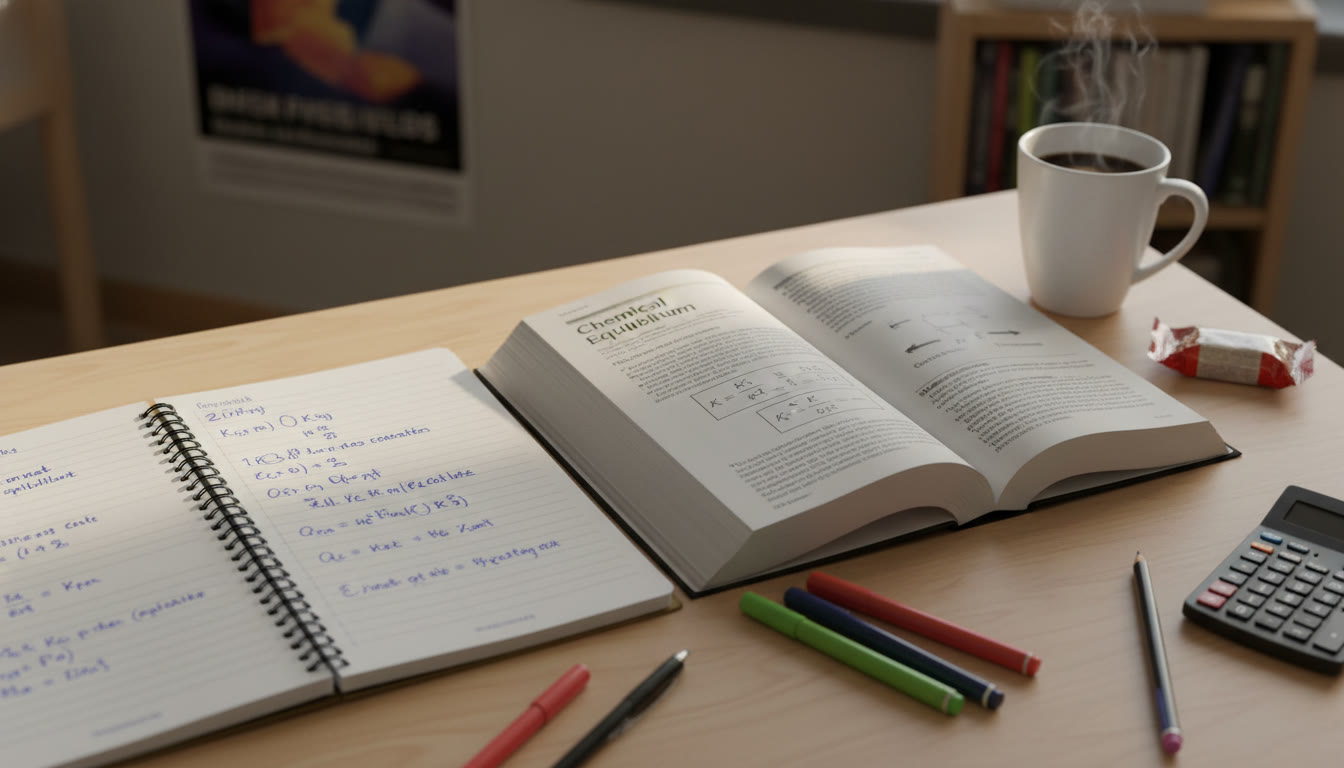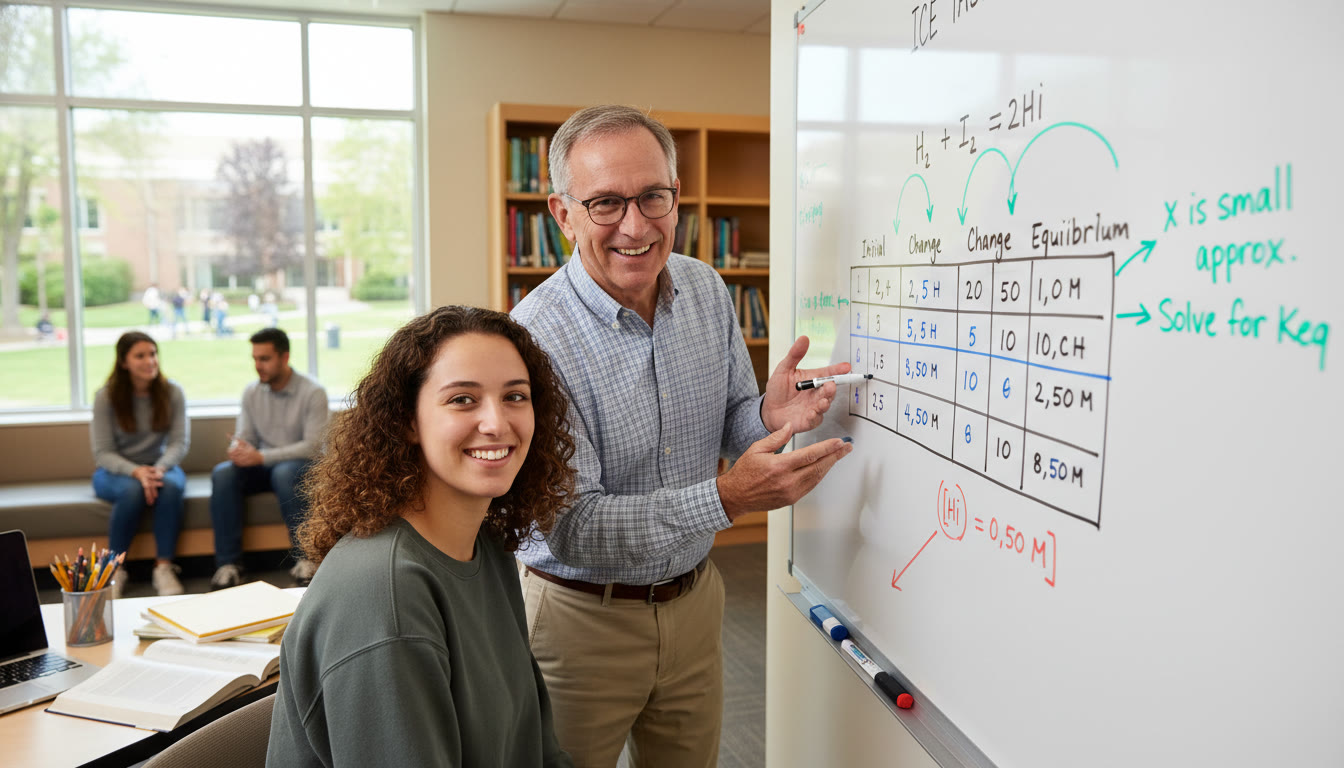Why Equilibrium Matters (and Why You Should Care)
Equilibrium is one of those chemistry topics that shows up everywhere—reaction rates, solubility, acids and bases, electrochemistry, even industrial chemical engineering. For AP Chemistry students, mastering equilibrium is not just about memorizing a formula: it’s about developing an intuition for how systems behave when pushed or nudged. In this post we’ll walk through the three pillars you must know: the equilibrium constant K, the reaction quotient Q, and Le Châtelier’s Principle. We’ll use clear examples, a helpful table, and practical tips so you can turn confusion into confidence.

At the Heart: What Is Chemical Equilibrium?
Chemical equilibrium occurs in a closed system when the forward and reverse reaction rates are equal. That doesn’t mean molecules stopped reacting—rather, the concentrations of reactants and products remain constant over time because the processes balance each other out. You can think of equilibrium like two people pushing a door from either side with equal force: the door isn’t moving, but both are still pushing.
Important features of equilibrium:
- It is dynamic, not static.
- It depends on temperature (K is temperature-dependent).
- Concentration, pressure (for gases), and catalysts affect how quickly equilibrium is reached—but only temperature changes the value of K.
Equilibrium Constant (K): The Thermodynamic Snapshot
The equilibrium constant, K, is a number that expresses the ratio of product concentrations to reactant concentrations at equilibrium, each raised to the power of its stoichiometric coefficient. For the general reaction:
aA + bB ⇌ cC + dD
The expression for the equilibrium constant in terms of concentration is:
Kc = [C]^c [D]^d / [A]^a [B]^b
For gas-phase reactions you can use partial pressures and write Kp. Be careful: Kc and Kp are not the same number unless the reaction has no change in moles of gas (Δn = 0).
Key points about K
- K is constant at a given temperature. If you change the temperature, K changes.
- If K >> 1, products are favored at equilibrium (mostly products present).
- If K << 1, reactants are favored (mostly reactants present).
- K has no units in the strict thermodynamic sense (it may be represented with concentration units depending on context, but treat K as a dimensionless ratio in most problems).
Reaction Quotient (Q): Where the System Is Right Now
Q has the same mathematical form as K, but it uses the current (instantaneous) concentrations or partial pressures—not the equilibrium values. Q tells you the direction the reaction will spontaneously proceed to reach equilibrium:
- If Q < K, the reaction will proceed forward (make more products) until Q = K.
- If Q > K, the reaction will proceed in reverse (make more reactants) until Q = K.
- If Q = K, the system is at equilibrium.
So Q is like a snapshot debit/credit balance; comparing it to K tells you which side is “in debt.”
Practical strategy: computing Q and comparing
1. Write the expression for K (or Q) from the balanced equation. 2. Plug current concentrations for Q. 3. Compare Q to the known K. 4. Predict direction and describe what will happen to concentrations as equilibrium is approached.
Le Châtelier’s Principle: Predicting the Shift
Le Châtelier’s Principle is the go-to qualitative rule for predicting how an equilibrium system responds to a disturbance. It says: when a system at equilibrium is disturbed, it will shift in the direction that reduces that disturbance.
Common stresses and expected shifts
- Concentration change: Adding a reactant shifts toward products; removing a reactant shifts toward reactants.
- Pressure change (gases): Increasing pressure by decreasing volume shifts toward fewer moles of gas; decreasing pressure shifts toward more moles of gas.
- Temperature change: Treat as changing K. For an exothermic reaction (heat released as product), increasing temperature shifts equilibrium left (toward reactants)—because added heat is like adding a product. For an endothermic reaction, increasing temperature shifts right.
- Catalysts: Speed up reaching equilibrium but do not change K or the position of equilibrium.
Why temperature is special
Unlike concentration or pressure, temperature actually alters K because it changes the reaction’s energy distribution. So when temperature changes, you must use the new K to evaluate the new equilibrium composition.
Worked Examples: K, Q, and Le Châtelier in Action
Let’s walk through representative examples you might see on AP-style problems. Work them slowly and check your units and stoichiometry—errors often come from simple algebra or plugging the wrong values.
Example 1: Using K and Q to predict direction
Consider the reaction: N2(g) + 3H2(g) ⇌ 2NH3(g). Suppose Kc (at the given temperature) = 1.6 × 10^5. If initial concentrations are [N2] = 0.10 M, [H2] = 0.30 M, and [NH3] = 0.020 M, what direction will the reaction proceed?
Compute Qc = [NH3]^2 / ([N2][H2]^3) = (0.020)^2 / (0.10 × 0.30^3). Work it out: numerator 0.0004; denominator 0.10 × 0.027 = 0.0027; Qc ≈ 0.0004 / 0.0027 ≈ 0.148.
Compare Qc (≈0.148) to Kc (1.6 × 10^5). Q ≪ K, so the reaction will move forward to form more NH3.
Example 2: Le Châtelier and temperature
For the exothermic reaction below:
2SO2(g) + O2(g) ⇌ 2SO3(g) ΔH = −198 kJ (exothermic)
If the temperature is increased, predict the shift and the effect on K. Since the reaction is exothermic, adding heat shifts the equilibrium left (toward reactants) and decreases K.
Example 3: Pressure change with gases
If you compress the container for the reaction above (decreasing volume), the equilibrium shifts toward fewer moles of gas. Here: left side moles = 3, right side moles = 2, so the system shifts right (toward SO3) when pressure increases.
Clear Table: Quick Reference for K, Q, and Le Châtelier
| Concept | Definition/Expression | What It Tells You | When It Changes |
|---|---|---|---|
| K (Equilibrium Constant) | Kc = [products]^coeff / [reactants]^coeff | Relative amounts at equilibrium; product vs reactant favored | Only changes with temperature |
| Q (Reaction Quotient) | Same form as K but with current concentrations | Direction the reaction will shift to reach equilibrium (compare Q to K) | Changes whenever concentrations or pressures change |
| Le Châtelier’s Principle | Qualitative rule: system opposes imposed change | Predicts direction of shift when stressed by concentration, pressure, temperature | Describes response to stresses; temperature stress alters K |
AP-Focused Problem-Solving Tips
AP exam problems often combine algebra with conceptual reasoning. Here are study-smart strategies:
- Write the balanced equation first and explicitly list initial, change (±x), and equilibrium values (ICE table). Clear organization reduces arithmetic mistakes.
- If K is very large or very small, consider approximations (e.g., when K ≫ 1, assume reactant consumption is small if initial reactant concentration is large)—but always check the validity of the approximation (typically the change should be less than 5% of the initial value).
- Be explicit about units when working with Kp vs Kc. Convert pressures to atmospheres for Kp, and remember Kp = Kc(RT)^Δn when necessary.
- When temperature changes, don’t try to use Le Châtelier qualitatively and ignore K—if the exam gives a new temperature or a new K, use the numeric K to get quantitative results.
- Label everything on the answer sheet: state assumptions, show steps, and box your final numeric result with units. This clarity helps partial-credit scoring on AP free-response questions.
Common Pitfalls and How to Avoid Them
- Forgetting to square or cube concentrations according to stoichiometric coefficients when writing K or Q. Always map coefficients to exponents.
- Mixing Kc and Kp without conversion—remember Δn and the RT term for conversions.
- Using Le Châtelier qualitatively when the problem requires a numerical answer. If temperature changes, you often need the new K to compute new equilibrium concentrations.
- Assuming catalysts change K. They only change the speed to reach equilibrium.
Practice Set (Try These Yourself)
Work these problems and check your answers by redoing each with an ICE table.
- 1) For the reaction H2(g) + I2(g) ⇌ 2HI(g), Kc = 50.0 at the temperature given. If you start with 0.20 M H2, 0.20 M I2, and 0 M HI, find equilibrium concentrations.
- 2) For N2O4(g) ⇌ 2NO2(g), Kp = 0.113 at a temperature. If the total pressure in a 1.00 L flask at equilibrium is 0.500 atm and only these two gases are present, what are the partial pressures and Kp relationship? (Hint: let pN2O4 = x)
- 3) For a system at equilibrium, explain qualitatively how adding an inert gas at constant volume affects position of equilibrium and why.
How to Study So It Sticks
Practicing random problems is good, but deliberate practice is better. Try this weekly routine:
- Day 1: Concept refresh—read a clear summary and rewrite the K and Q expressions from memory.
- Day 2: Do 4–6 mixed problems (Kc, Kp, ICE tables), focusing on method rather than speed.
- Day 3: Take a timed practice passage from an AP-like exam and identify the equilibrium-related questions. Review your errors.
- Day 4: Teach someone (a study buddy or even yourself aloud) one or two solved problems—explain each step slowly.
- Day 5: Target weak spots with short focused problems (e.g., temperature effects, Kp conversions).
Pair this with periodic cumulative reviews so you don’t forget earlier topics.
When You Need a Little Extra Help
It’s normal to hit plateaus—the trick is how you break through them. Personalized help can pinpoint where you lose time or confidence: is it algebra, symbolic manipulation, or conceptual reasoning? Services that offer 1-on-1 guidance and tailored study plans can accelerate progress by focusing on your specific gaps and tracking improvement. For instance, Sparkl’s personalized tutoring can provide targeted 1-on-1 sessions, custom study schedules, and AI-driven insights that adapt to your pace—helpful when you want faster, more efficient learning without wasting study hours on what you already know.

Advanced Connections: K, Free Energy, and Industrial Context
Equilibrium constants are more than test questions—they tie directly into thermodynamics. At temperature T, the relationship between the standard Gibbs free energy change and the equilibrium constant is:
ΔG° = −RT ln K
This tells you that K is a measure of spontaneity when reactants and products start in their standard states. In industry, chemists use Le Châtelier’s insights along with thermodynamics to optimize yields—for example, adjusting pressure and temperature in the Haber process (N2 + 3H2 ⇌ 2NH3) to favor ammonia production while keeping reaction rates practical. That balance—thermodynamics versus kinetics—is a beautiful real-world application of these classroom ideas.
Quick Review: Pocket Checklist Before the AP Exam
- Can you write K expressions from balanced equations? (Include phases.)
- Do you know when to use Kc versus Kp and how to convert between them?
- Can you compute Q and predict the reaction direction quickly?
- Can you set up and solve ICE tables, and when to use approximations?
- Will you remember that only temperature changes K, while concentration/pressure changes Q?
- Do you understand how Le Châtelier predicts shifts for concentration, pressure, and temperature changes?
Final Thoughts (A Little Motivation)
Equilibrium problems reward clarity: clear setup, careful algebra, and a calm step-by-step approach. If you make a habit of writing balanced equations first, labeling ICE tables, and checking approximations, you’ll find that even unfamiliar problems become manageable. Practice with purpose, and when you get stuck, ask for focused help: a quick 1-on-1 session can save you hours and give your study the structure it needs. Sparkl’s tutoring approach—tailored plans, expert tutors, and adaptive insights—can be an efficient companion on the path to AP success, especially when you’re trying to convert understanding into speed and accuracy under exam conditions.
Parting Tip
When you see an equilibrium question on the AP: breathe, write the equation, list knowns, pick a strategy (ICE, algebraic substitution, or approximation), and solve methodically. Equilibrium is a test of patience and reasoning as much as memory—play to that strength.
Now Go Practice
Open a blank page, pick one of the practice problems above, and time yourself. After you finish, rework any step that took more than a minute. That deliberate sharpening is how good students become great test-takers.

















No Comments
Leave a comment Cancel